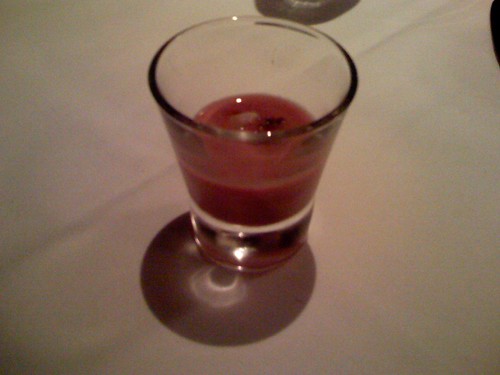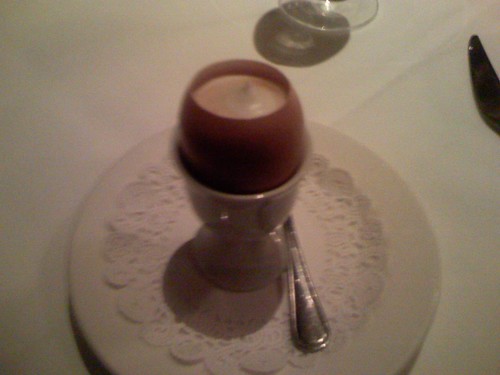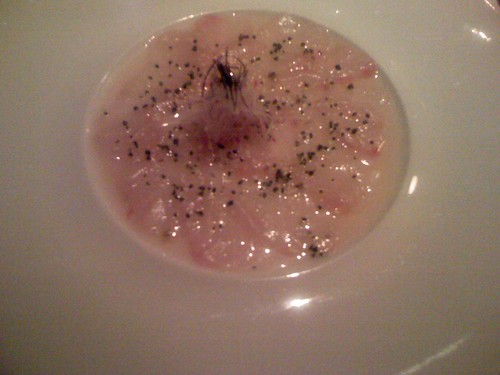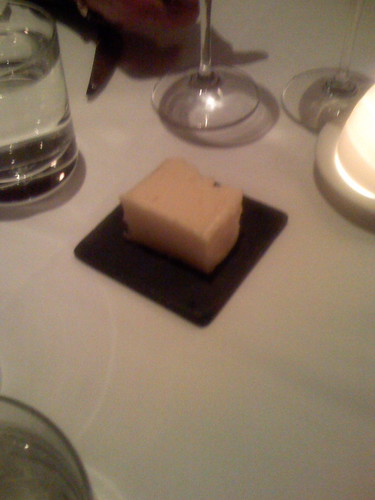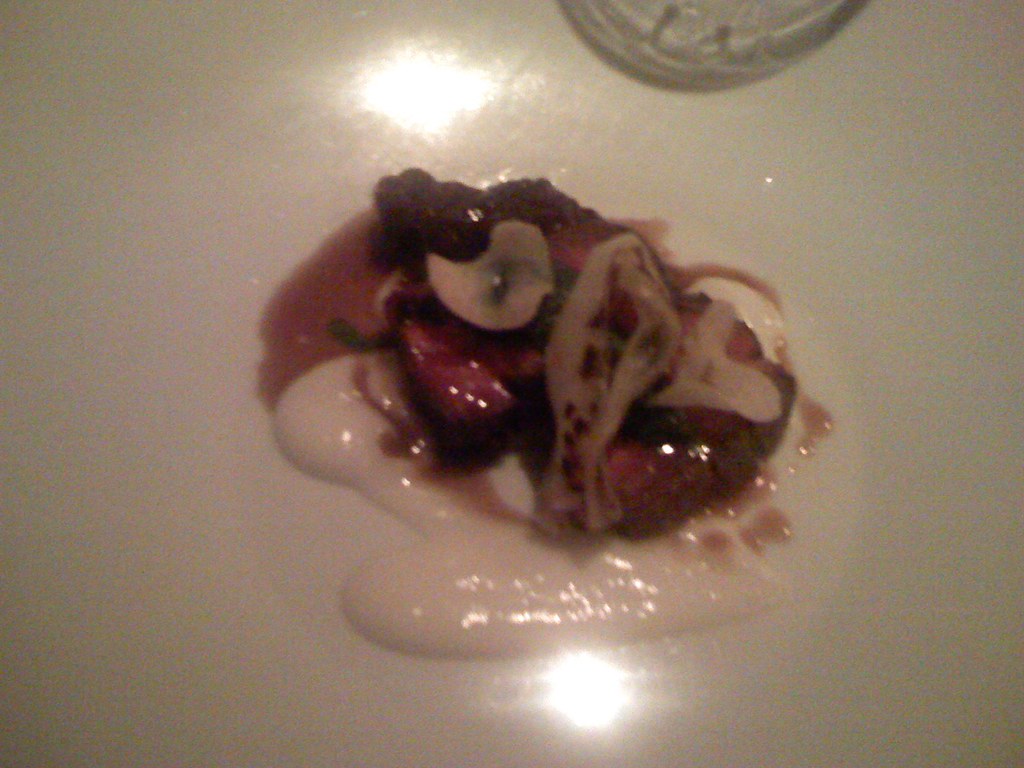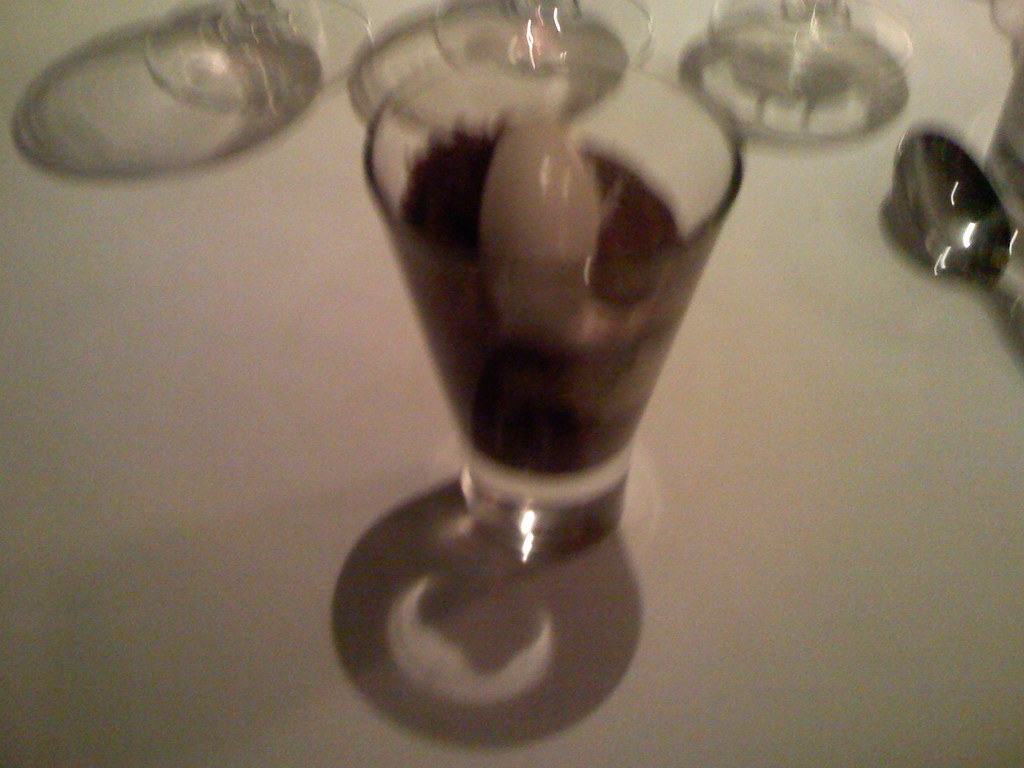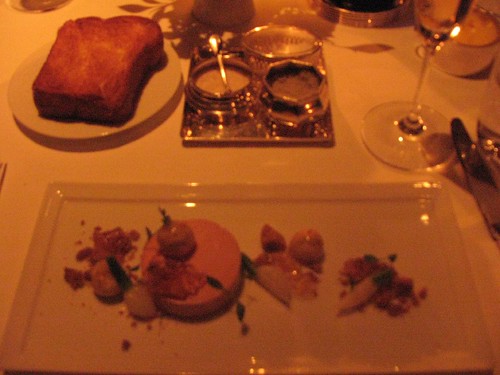
Restaurant: The French Laundry
Location: Yountville, CA
Open: Daily 5:30-9:30pm; Friday-Sunday 11:00am-1:00pm
Date of Dinner: October 20, 2007
Cost of Dinner: $300 per person
Recommendation: A must for every foodie.

In the interest of full disclosure, I did not enjoy my first visit to The French Laundry over 5 years ago. At that time, I did not understand what all the fuss was about or why it had garnered all those accolades, because I did not think any of the dishes we tried were exceptional or memorable.
"Whatever you do, you have to try the coffee and donuts," exclaimed the friend who got us the reservation. So I did, and what a disappointment! "Coffee and Donuts" was one of The French Laundry's signature desserts, wherein pot de creme is served in a coffee cup and comes with powdered cinnamon beignets. I found it cloyingly sweet and really am perplexed as to why everyone praises it to high heaven.
Flash forward five years to 2007 and I am ready to try The French Laundry again. I want to believe that they might have had a bad day when I went. I also can't believe that I'm missing something that everybody else seem to be experiencing to the point that in the most recent poll by Restaurant Magazine, it placed fourth in its list of the 50 best restaurants in the world. It is also the only restaurant in the Bay Area to receive 3 stars from Guide Michelin.
The menu has changed considerably since we went over 5 years ago. It is now a set menu and comprises nine courses. You can either choose the chef's tasting menu or a tasting of vegetables menu. Either menu costs $240, including service. According to the waiter, the dishes in either menu are ordered by progression of tastes, so we cannot, at least they really advise against it, switch dishes between the two menus.
For maximum effect, one of our party of four decided to opt for the vegetable tasting menu while the rest had the tasting menu. This way, we can all try a little bit of most of what French Laundry has to offer.
Dinner starts with two amuses bouches: first are gougères, savory pates au choux made with gruyere cheese with a creme fraiche filling. The second are one of Thomas Keller's signature dishes: cornettes of salmon tartare with creme fraiche.
THE CHEF'S TASTING MENU
"Oysters and Pearls" - This is the first of what I call The French Laundry's surrealistic dishes, a tongue-in-cheek take on traditional dishes or other ideas. In this first course, a sabayon of tapioca pearls is served with Beau Soleil oysters and a generous dollop of White Sturgeon caviar. The sabayon is a warm savory custard made by beating egg yolks with a liquid over simmering water until thickened and frothy. The little pearls of white sturgeon caviar gives this dish sophisticated character, while the tapioca pearl and sabayon cream is a good counterpoint to the ocean saltiness of the caviar and oysters. Amazing! This one dish alone removes all bad memories from five years ago.
Salad of Caramelized Belgian Endive - I have never liked Belgian endives. However, having them caramelized and served with relish of Philo Gold apples and young red beets cuites sous vide give the endives a nice taste to them. The endives are nicely crunchy with a nice watercress vinaigrette. It seems food cooked sous vide has been en vogue lately. In fact, in the finale of Top Chef, one of Hung's (the winning chef) signature dishes was duck cuite sous vide. So, sous vide is French for "under vacuum" and is a method for cooking ingredients in air-tight packages, usually vacuum sealed plastic bags, under relatively low temperature for an extended period of time. It has been somewhat controversial when used in the US. Last year, the New York City Department of Health cracked down on restaurants using the technique, concerned about safe food handling, since cooking in low temperature may foster the growth of the botulinum bacteria in the absence of oxygen. In this instance, by cooking the beets sous vide gives the beets a more intense flavor.
Moulard Duck "Foie Gras au Torchon" - Moulard duck is the cross between the Pekin and the Muscovy duck. This hybrid results in a very large duck and is raised primarily for the production of foie gras. To cook foie gras au torchon, the liver is pressed tightly in cheesecloth and then poached. It is then allowed to cool slowly in the poaching liquid. In the first of two courses that carry a supplement on top of the already steep $240 tasting menu, this version served by The French Laundry comes with a very long prologue. It includes a very long explanation by the server.
I've always thought that foie gras au torchon is the same or similar to pate de foie gras, so it was a big surprise to me that this dish carried a supplement. The waiter quickly removed that feeling when he explained the difference: au torchon is pure foie gras while the pate includes pork, salt and spices.
The foie gras was the main part of this dish, but it, by no means, is the only part of the dish. Also on the plate are Gros Michel bananas, Tokyo turnips, Banyuls vinegar gelee, and a smattering of spiced streusel. The foie is spread and eaten with a generous portion of toasted brioche bread and three different kinds of salts: sel gris from Brittany, France; Kuroshio salt from the southern coast of Japan, and Jurassic salt that the server told us is 40 million years old and is harvested from a copper mine in Montana. Now all of a sudden the $30 supplement doesn't seem so steep after all.
Gros Michel bananas, or Big Mike, was supposedly the bananas that were referred to in the song, "Yes, We Have No Bananas." In the first half of the 20th century, it was the type of banana that most Americans and people living in non-tropical areas came to know and love. They are bigger than the bananas we know now and most say are sweeter. However, this species was devastated when a fungus called the Panama disease began infecting Big Mike in the 1920s. By the 60s, most exporters of the fruit were bankrupt and the Gros Michel is practically extinct. I certainly feel special to now have tasted an almost extinct plant and have it paired with foie gras and Jurassic salt. It's so very surreal.
 "Tartare" of Nova Scotia Bluefin Tuna - This "tartare" is really more like sashimi, instead of tartare. The traditional tartare is made from chopped meat, usually steak. In this version, the pieces of Bluefin tuna are quite substantial. On an elliptical plate, the tuna are interspersed with raisins, nicoise olives, Marcona almonds, arugula, and cauliflower scented with Spanish saffron. All of these are served on top of coulis made from slow-baked tomatoes. The Nova Scotia Bluefin tuna is the largest member of its species and are usually prized by tuna aficionados. They are exclusively sold for sushi consumption. The tuna here is definitely exceptional, buttery and very fresh.
"Tartare" of Nova Scotia Bluefin Tuna - This "tartare" is really more like sashimi, instead of tartare. The traditional tartare is made from chopped meat, usually steak. In this version, the pieces of Bluefin tuna are quite substantial. On an elliptical plate, the tuna are interspersed with raisins, nicoise olives, Marcona almonds, arugula, and cauliflower scented with Spanish saffron. All of these are served on top of coulis made from slow-baked tomatoes. The Nova Scotia Bluefin tuna is the largest member of its species and are usually prized by tuna aficionados. They are exclusively sold for sushi consumption. The tuna here is definitely exceptional, buttery and very fresh.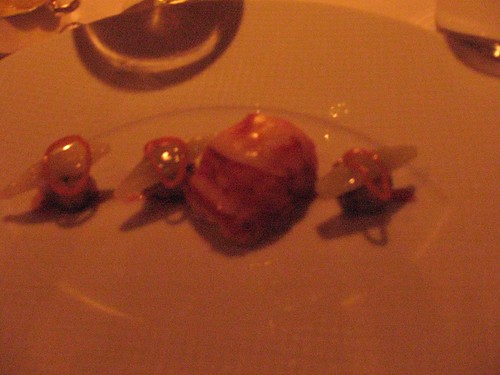 Sweet Butter-Poached Maine Lobster Tail - Lobster tail has been poached in sweet butter and served stylishly with a fennel bulb, jingle bell peppers, mint and tamarind-glazed eggplant, all stacked neatly. The lobster was amazingly soft and well flavored by the sweet butter without being inundated by the butter if it had been served with the lobster as a dip.
Sweet Butter-Poached Maine Lobster Tail - Lobster tail has been poached in sweet butter and served stylishly with a fennel bulb, jingle bell peppers, mint and tamarind-glazed eggplant, all stacked neatly. The lobster was amazingly soft and well flavored by the sweet butter without being inundated by the butter if it had been served with the lobster as a dip. "Pork and Beans" - I remember the very first time I saw pork belly in a menu, the waiter made sure that everyone at the table understands that it is the fattiest cut of pork. At that time, I was the only one at the table of eight to venture out and order the pork belly. As it turned out, my dish was the most flavorful of all the dishes ordered that night. I was hooked. Now, every time I see pork belly in a menu, it is mine! To see it with such a whimsical title, how can I resist? Pork belly, of course, is the underside of the pig and the meat from which bacon is made. For French Laundry's version, Kurobuta pork belly has been braised all day and served over a cassoulet of garden pole beans with whole-grain mustard sauce. In Japan, Kurobuta pork are prized as highly as Kobe or Wagyu beef and comes from an ancient breed known as the Black Berkshire pig. Kurobutas have incredible marbling and the texture is unbelievable. Of course, pork belly has always been the most flavorful part of the pig, so this makes for an even better combination. The pork belly has a wonderful taste. Usually pork bellies are very salty, not so here. Maybe the mustard sauce helps, but the texture is fantastic and the skin is crisp. Great combination.
"Pork and Beans" - I remember the very first time I saw pork belly in a menu, the waiter made sure that everyone at the table understands that it is the fattiest cut of pork. At that time, I was the only one at the table of eight to venture out and order the pork belly. As it turned out, my dish was the most flavorful of all the dishes ordered that night. I was hooked. Now, every time I see pork belly in a menu, it is mine! To see it with such a whimsical title, how can I resist? Pork belly, of course, is the underside of the pig and the meat from which bacon is made. For French Laundry's version, Kurobuta pork belly has been braised all day and served over a cassoulet of garden pole beans with whole-grain mustard sauce. In Japan, Kurobuta pork are prized as highly as Kobe or Wagyu beef and comes from an ancient breed known as the Black Berkshire pig. Kurobutas have incredible marbling and the texture is unbelievable. Of course, pork belly has always been the most flavorful part of the pig, so this makes for an even better combination. The pork belly has a wonderful taste. Usually pork bellies are very salty, not so here. Maybe the mustard sauce helps, but the texture is fantastic and the skin is crisp. Great combination.Herb-Roasted Saddle of Elysian Fields Lamb - Elysian Fields Farm is a small family-owned farm in Schoharie, NY. Their name is to lamb what Niman Ranch is to beef. Their lamb are prized for their taste and texture. The saddle of lamb, or lamb loin, is where the most tender and most expensive cuts of lamb come from. The beautiful cut we received on our plate was nicely marbled and tender as tender can be. It was herb roasted on top of thyme jus and served with mille-feuille of Yukon Gold potatoes, baby artichokes, Nantes carrots, and sweet garlic pudding. Literally meaning a thousand layers, the mille feuille of potatoes was a light airy version of potatoes au gratin.
Grilled "Pave" of Japanese "Wagyu" -
"Gabietou" -
Persian Lime Sorbet -
"S'Mores" -
"Charlotte aux Poires et aux Dates" -
TASTING OF VEGETABLES
Perigord Truffle "Veloute" -
Salad of Matsutake Mushrooms -
Tahitian Vanilla Glazed Salsify -
Hand-Rolled Potato "Gnocchi" -
Belgian Endive "Cuite Sous Vide" -
Betteraves Parfumees a la Feuille de Peche" -
"Mestre Queijeiro Cabra" -
Huckleberry Sorbet -
"Pave de Chocolat Blanc au The Vert" -
